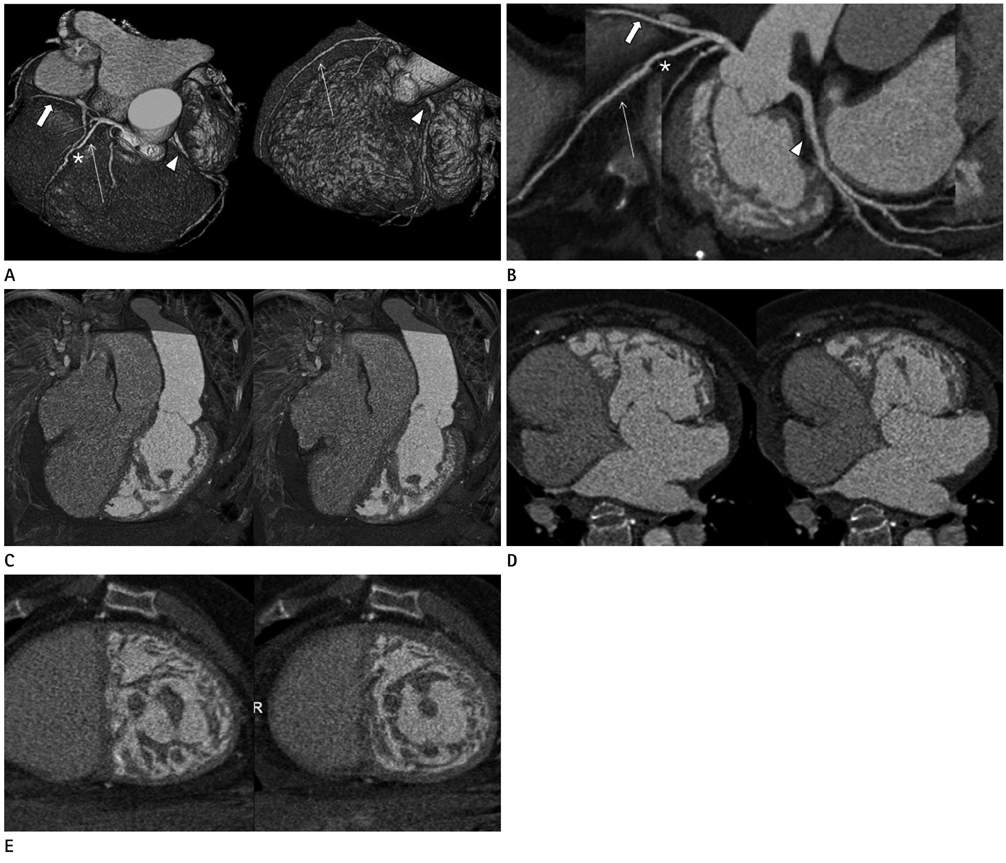J Korean Soc Radiol.
2013 Sep;69(3):197-200. 10.3348/jksr.2013.69.3.197.
A Case Report of Congenitally Corrected Transposition of Great Arteries: Morphologic and Functional Evaluation with Cardiac CT
- Affiliations
-
- 1Department of Radiology, College of Medicine, Soonchunhyang University, Bucheon Hospital, Bucheon, Korea. acarad@naver.com
- 2Department of Cardiology, College of Medicine, Soonchunhyang University, Seoul Hospital, Seoul, Korea.
- KMID: 2208801
- DOI: http://doi.org/10.3348/jksr.2013.69.3.197
Abstract
- Congenitally corrected transposition of the great arteries (ccTGA) is a rare congenital anomaly characterized by atrioventricular and ventriculoarterial discordance. We report a case of new-onset heart failure in a 69-year-old female in whom cardiac CT demonstrated ccTGA without the associated cardiovascular anomalies. In this case, cardiac CT was useful for elucidating the rare and unexpected congenital etiologies of abrupt-onset heart failure in an old patient by the simultaneous evaluation of cardiac morphology and function as a single study (inserted).
MeSH Terms
Figure
Reference
-
1. Wallis GA, Debich-Spicer D, Anderson RH. Congenitally corrected transposition. Orphanet J Rare Dis. 2011; 6:22.2. Kharge J, Prasad MR, Ramegowda RT. An unusual case of congenitally corrected transposition of the great arteries associated with noncompaction-like remodeling of the morphological right ventricle. Echocardiography. 2011; 28:E212–E214.3. Nagle JP, Cheitlin MD, McCarty RJ. Corrected transposition of the great vessels without associated anomalies: report of a case with congestive failure at age 45. Chest. 1971; 60:367–370.4. Graham TP Jr, Bernard YD, Mellen BG, Celermajer D, Baumgartner H, Cetta F, et al. Long-term outcome in congenitally corrected transposition of the great arteries: a multi-institutional study. J Am Coll Cardiol. 2000; 36:255–261.5. Patrignani A, D'Aroma A, Cicogna S. Unusual association between "congenitally corrected transposition of the great arteries" and "noncompaction" of the right systemic ventricle. Int J Cardiovasc Imaging. 2009; 25:551–553.6. Purvis J, Barr S. An appearance of "non-compaction" of the right systemic ventricle is common in "congenitally corrected transposition of the great arteries. Int J Cardiovasc Imaging. 2009; 25:751–752.7. Ruzsics B. Integrative computed tomography imaging of ischemic heart disease. J Thorac Imaging. 2010; 25:231–238.8. Chang DS, Barack BM, Lee MH, Lee HY. Congenitally corrected transposition of the great arteries: imaging with 16-MDCT. AJR Am J Roentgenol. 2007; 188:W428–W430.
- Full Text Links
- Actions
-
Cited
- CITED
-
- Close
- Share
- Similar articles
-
- Transposition of the Great Arteries: Historical Background
- An Adult Case of Congenitally Corrected Transposition of the Great Arteries Associated with Paroxysmal Atrial Fibrillation and Heart Failure
- Congenitally Corrected Transposition of the Great Arteries
- Right Ventricular Inflow Obstruction Caused by Supratricuspid Ring after the Conventional Biventricular Repair of Congenitally Corrected Transposition of Great Arteries: A case report
- A case of isolated congenitally corrected transposition of the great arteries with complete atrioventricular block


